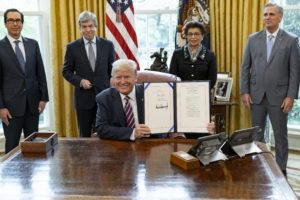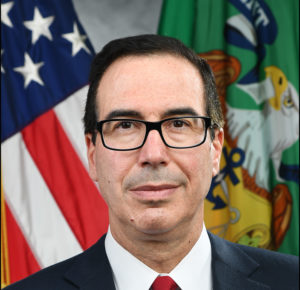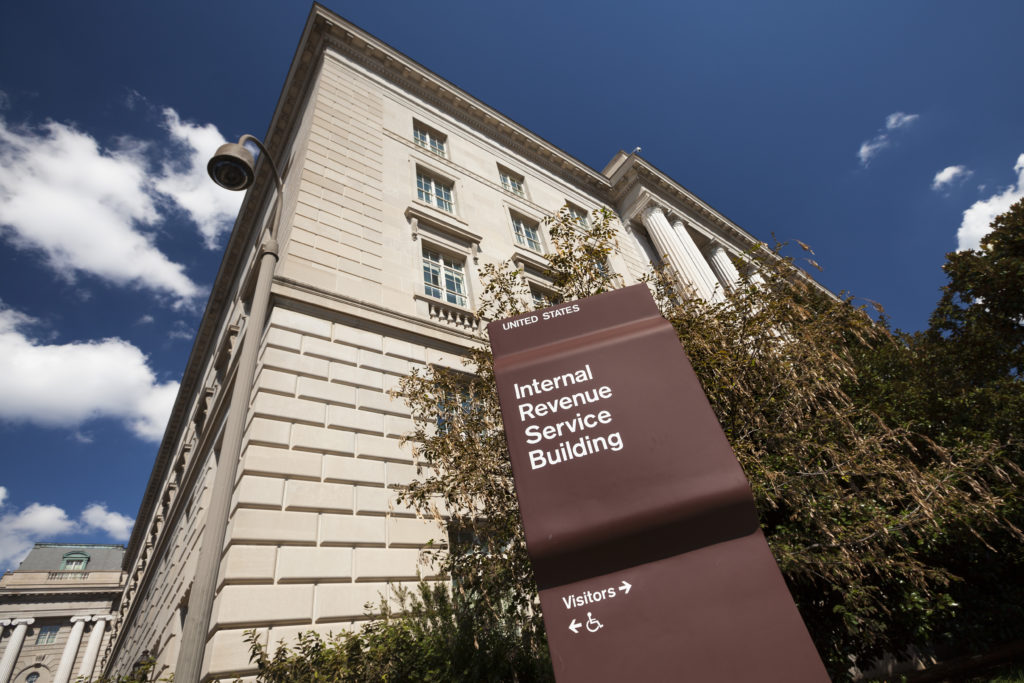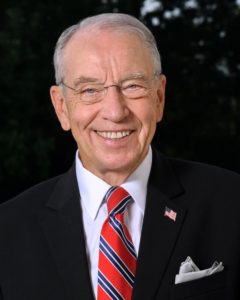
COVID-19 biz relief: ‘Safe harbor’ nears, 100% forgivable PPP money remains, tax change sought
By onAnnouncements | Business Practices | Education | Legal | Market Trends | Repair Operations
Collision repairers who hustled to claim Paycheck Protection Program loans as a precaution for a COVID-19 economic slump but realized they didn’t need the money after all can repay the funds without risk through Thursday.
The Treasury Department recently extended the “safe harbor” date from May 7 to May 14. Anyone who repays PPP money by then is presumed to have requested it in good faith.
The Small Business Administration will review all Paycheck Protection Program loans of more than $2 million, “in addition to other loans as appropriate.”
Just because you run a small business during a lousy pandemic economy doesn’t mean you automatically deserve PPP funds, according to the government. Recipients must confirm that they needed the money.
“Although the CARES Act suspends the ordinary requirement that borrowers must be unable to obtain credit elsewhere (as defined in section 3(h) of the Small Business Act), borrowers still must certify in good faith that their PPP loan request is necessary,” an April 23 FAQ response by Treasury and the SBA states. “Specifically, before submitting a PPP application, all borrowers should review carefully the required certification that “[c]urrent economic uncertainty makes this loan request necessary to support the ongoing operations of the Applicant.” Borrowers must make this certification in good faith, taking into account their current business activity and their ability to access other sources of liquidity sufficient to support their ongoing operations in a manner that is not significantly detrimental to the business. For example, it is unlikely that a public company with substantial market value and access to capital markets will be able to make the required certification in good faith, and such a company should be prepared to demonstrate to SBA, upon request, the basis for its certification.”
The auditing is probably aimed at the well-known national brands which made headlines for taking PPP money. But collision repairers might still wish to consult with financial and legal advisors and see if it makes sense to repay the money by the Thursday deadline.
Loan dollars still available
Money repaid by Thursday will join the pot of money still available to auto body shops and other small businesses in need. As of 5 p.m. Sunday, more than $188 billion had been approved across 2,575,182 loans. That means more than $100 billion allocated by Congress for PPP “Round Two” remains available for the nation’s small businesses. The average Round Two loan so far has been $73,017.
The two-year, 1 percent interest loans are available at banks and even “fintech” online options like PayPal nationwide; SBA guarantees the loans, meaning there’s no risk to the banks.
Businesses can borrow about 2.5 months worth of payroll, up to $10 million. The SBA forgives the whole thing and interest if the money was spent during an eight-week period; it decreases the forgiveable amount proportional to cuts in the company’s workforce or pay. At least 75 percent of the borrowed amount must go to payroll during those eight weeks, the remaining 25 percent can be used for certain eligible expenses including utilities and rent.
“The amount of loan forgiveness can be up to the full principal amount of the loan and any accrued interest,” the SBA wrote April 15. “That is, the borrower will not be responsible for any loan payment if the borrower uses all of the loan proceeds for forgiveable purposes described below and employee and compensation levels are maintained. The actual amount of loan forgiveness will depend, in part, on the total amount of payroll costs, payments of interest on mortgage obligations incurred before February 15, 2020, rent payments on leases dated before February 15, 2020, and utility payments under service agreements dated before February 15, 2020, over the eight-week period following the date of the loan. However, not more than 25 percent of the loan forgiveness amount may be attributable to non-payroll costs.”
Repairers can use the SBA’s PPP application form to get started on the process. The American Institute of CPAs has also issued recommendations on documents to have ready when applying for a PPP loan; see them here.
Loan forgiveness
The SBA and Treasury haven’t yet issued official guidance on the loan forgiveness application process. However, repairers can find a few details in the agencies’ May 6 PPP FAQs — including how to handle a situation where employee you’re trying to rehire won’t come back.
Question: The amount of forgiveness of a PPP loan depends on the borrower’s payroll costs over an eight-week period; when does that eight-week period begin?
Answer: The eight-week period begins on the date the lender makes the first disbursement of the PPP loan to the borrower. The lender must make the first disbursement of the loan no later than ten calendar days from the date of loan approval. …
Question: To determine borrower eligibility under the 500-employee or other applicable threshold established by the CARES Act, must a borrower count all employees or only full-time equivalent employees?
Answer: For purposes of loan eligibility, the CARES Act defines the term employee to include “individuals employed on a full-time, part-time, or other basis.” A borrower must therefore calculate the total number of employees, including part-time employees, when determining their employee headcount for purposes of the eligibility threshold. For example, if a borrower has 200 full-time employees and 50 part-time employees each working 10 hours per week, the borrower has a total of 250 employees.
By contrast, for purposes of loan forgiveness, the CARES Act uses the standard of “full-time equivalent employees” to determine the extent to which the loan forgiveness amount will be reduced in the event of workforce reductions. …
Question: Will a borrower’s PPP loan forgiveness amount (pursuant to section 1106 of the CARES Act and SBA’s implementing rules and guidance) be reduced if the borrower laid off an employee, offered to rehire the same employee, but the employee declined the offer?
Answer: No. As an exercise of the Administrator’s and the Secretary’s authority under Section 1106(d)(6) of the CARES Act to prescribe regulations granting de minimis exemptions from the Act’s limits on loan forgiveness, SBA and Treasury intend to issue an interim final rule excluding laid-off employees whom the borrower offered to rehire (for the same salary/wages and same number of hours) from the CARES Act’s loan forgiveness reduction calculation. The interim final rule will specify that, to qualify for this exception, the borrower must have made a good faith, written offer of rehire, and the employee’s rejection of that offer must be documented by the borrower. Employees and employers should be aware that employees who reject offers of re-employment may forfeit eligibility for continued unemployment compensation. (Minor formatting edits.)
The American Institute of CPAs on May 1 urged the government to hurry up with the forgiveness guidance and offered the feds some suggestions, including:
• the 8-week covered period under PPP should align with the beginning of a pay period, not the date loan proceeds are received;
• the 8-week period should commence when restrictions are lifted and the borrower is allowed to operate, not when loan proceeds are received, so small businesses have adequate funds to ramp up operations;
• full-time job equivalents (FTEs) can be calculated using a simple wage-based proxy when hours worked are not tracked by the employer, and
• Payroll reduction calculations should be based on average payroll per employee per week, not total compensation per employee. (Minor formatting edits.)
Taxes
Borrowers should also be aware of the government’s tax guidance for PPP revenues.
The Internal Revenue Service in Notice 2020-32 explained that you can’t deduct a typically deductible expense if paying that expense allowed you to qualify for Paycheck Protection Program loan forgiveness. The CARES Act excludes forgiven loan dollars from gross income, which makes it a “class of exempt income” that can’t be deducted, according to the IRS.
“Consistent with the purpose of section 265, this treatment prevents a double tax benefit,” the IRS explained.
So you can’t deduct it, but it’s not taxable income either.
“This notice provides guidance regarding the deductibility for Federal income tax purposes of certain otherwise deductible expenses incurred in a taxpayer’s trade or business when the taxpayer receives a loan (covered loan) pursuant to the Paycheck Protection Program under section 7(a)(36) of the Small Business Act (15 U.S.C. 636(a)(36)),” the IRS wrote. “Specifically, this notice clarifies that no deduction is allowed under the Internal Revenue Code (Code) for an expense that is otherwise deductible if the payment of the expense results in forgiveness of a covered loan pursuant to section 1106(b) of the Coronavirus Aid, Relief, and Economic Security Act (CARES Act), Public Law 116-136, 134 Stat. 281, 286-93 (March 27, 2020) and the income associated with the forgiveness is excluded from gross income for purposes of the Code pursuant to section 1106(i) of the CARES Act.”
Crowgey & Associates attorney Guy Crowgey recently explained the notice to a collision repairer, calling it “Very clear guidance.”
“Bottom line, the PPP forgiveness funds are NOT taxable income,” Crowgey wrote in an email the shop permitted us to quote. “But the Payroll expenses, Rent, and related expenses paid for by the PPP are NOT deductible. It is deemed as expenses not paid by your company, therefore, not deductible (cannot claim them).”
We asked the AICPA how the IRS would normally handle traditional business loan income and expenses paid with that income.
“It depends on the terms of a particular loan, but typically, the interest you pay on a business loan is a deductible business expense,” the trade group wrote. “The loan itself would be repaid. The Reason the PPP loan is different is because the government is allowing businesses an opportunity to receive forgiveness of the loan (loan becomes a grant).”
Though a business can borrow about 10 weeks of payroll, it appears you need to spend it all in eight weeks to have the loan forgiven.
“One hundred percent of the PPP loan is forgivable,” the AICPA wrote. “If a percentage of the loan is not forgivable because the business was not able to apply 75 percent of the loan towards payroll (or for other reasons), then the non-forgivable portion of the loan would be treated as a typical business loan – where the loan is returned according to the terms and interest paid on the loan would be a deductible business expense.”
However, this could change. A bipartisan group of senators has introduced S. 3612, which would let small businesses treat forgiven PPP expenses in the usual way.
“This legislation will remedy the IRS guidance and allow taxpayers to deduct covered expenses paid or incurred by an eligible recipient of a small business loan that is forgiven pursuant to section 1106(b)4 of the CARES Act,” AICPA tax executive committee Chairman Chrisopher Hess wrote to bill supporters on May 5.
“It is clear that Congress intended to allow a full deduction for PPP related expenses.”
Be heard: Congressional contact information can be found here.
More information:
SBA “Coronavirus (COVID-19): Small Business Guidance & Loan Resources”
SBA “Coronavirus Relief Options” page
SBA Paycheck Protection Program (PPP) webpage
PPP lenders in your state as of May 11, 2020
Paycheck Protection Program FAQs
SBA, May 6, 2020
“Main Street America Urgently Needs PPP Loan Forgiveness Calculation Guidance, Says AICPA”
American Institute of CPAs, May 1, 2020
AICPA recommendations on PPP documents and forgiveness
AICPA, April 28, 2020
“Bipartisan Senators Introduce Bill to Clarify Small Business Expense Deductions Under PPP”
Sen. Chuck Grassley’s office, May 6, 2020
Images:
From left, Secretary of the Treasury Steven Mnuchin; U.S. Sen. Roy Blunt, R-Mo.; Republican President Donald Trump; SBA Administrator Jovita Carranza; and House Minority Leader Kevin McCarthy, R-Calif., appear April 24, 2020, with Trump’s signature on House Resolution 266, the Paycheck Protection Program and Health Care Enhancement Act. The bill added billions more to the PPP program. (Shealah Craighead/White House)
Treasury Secretary Steven Mnuchin. (Provided by Treasury Department)
The IRS building in Washington, D.C. (Pgiam/iStock)
Sen. Chuck Grassley, R-Iowa. (Provided by Grassley’s office)



